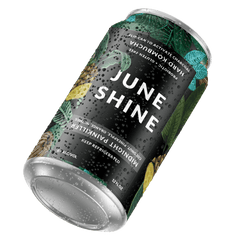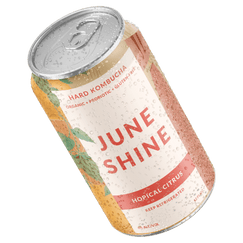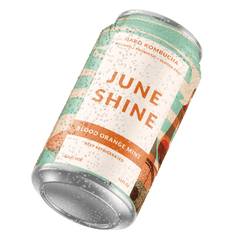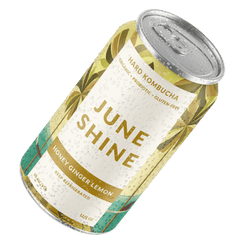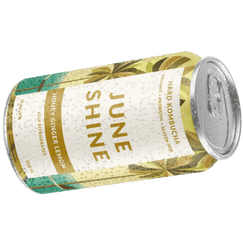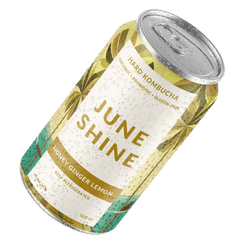Scoby: What It Is and How It Works

The perfect kombucha is not easy to make. It’s no simple task to choose the best ingredients and turn them into something magical, bright, and fizzy.
Of course, the true secret ingredient of kombucha is SCOBY, aka a symbiotic culture of yeast and bacteria. The SCOBY is responsible for fermenting the tea that eventually turns into booch, and using the right SCOBY makes all the difference.
Read on for a basic breakdown of SCOBY and how it works, so you’re totally up to speed with what goes into making your favorite hard kombucha.
The Basics of Scoby
SCOBY, aka a symbiotic culture of bacteria, is an opaque substance with gelatin-like consistency and a vinegary smell.
SCOBY’s appearance can vary, but it’s usually dense, round, and rubbery. This mushroom-like substance sits on top of your booch (which is why it’s sometimes called a pellicle or membrane), and it makes the magic happen as yeast and live bacteria thrive.
SCOBY is mainly composed of cellulose, along with all that yeast and bacteria we mentioned. When lactic acid bacteria, acetic acid bacteria, and yeast combine, fermentation starts—which is how we get the hard booch you know and love.
The Lowdown on Fermentation and Probiotics
As mentioned, SCOBY is used to ferment and produce kombucha.
Fermentation is a tried-and-true way to preserve food without preservatives or chemical additives. It is an ancient practice that’s still used to create many popular foods and drinks, from yogurt to sauerkraut.
When it comes to the science side, fermentation is a process in which yeast and bacteria convert starch and sugar into carbs. These carbs are then converted into acids or alcohol, which keep food from going bad as quickly.
Part of why fermented foods are so popular today is that they contain good bacteria called probiotics that give digestive health a boost. In traditional kombucha, we have SCOBY to thank for that.
Bacteria gets a bad reputation, but it’s time good bacteria got their due. Many of us think of bacteria as something that gets us sick, like a virus or pathogen—that’s just not it. While bad bacteria can have some nasty effects on the body, probiotics are the good bacteria that help keep us running smoothly.
SCOBY and Kombucha
Traditional kombucha has a long history. It’s been around for thousands of years, but its origins are a bit of a mystery.
Many believe that traditional kombucha originated in China in 221 BC during the Qin Dynasty, but others suspect it came from Japan. Kombucha earned the title "Tea of Immortality" because brewers truly believed in its powers to heal the body.
Both traditional and hard kombucha have the same SCOBY-centric fermentation. Hard kombucha contains around 6% ADV, while traditional kombucha contains 0.5%—and we do a second fermentation to get it there.
At JuneShine, we prefer Jun kombucha, which uses green tea and honey instead of black tea and sugar. This creates an organically delicious, smooth kombucha experience with no sugar and no B.S.—and we follow the same rules when it comes to our SCOBY.
To be worthy, SCOBY needs to be organic and of the highest quality to keep up with the rest of our ingredients.
How to Create SCOBY
To create your own SCOBY, you need a starter kit, almost like a sourdough kit. You can either buy a starter kit or borrow a kombucha starter from a friend who already makes their own SCOBY—in that case, you might want to borrow their kombucha recipe too.
It’s easy to share SCOBY because it grows in every new kombucha. It is simple—just cut an inch from the top and keep the good times rolling.
Starting from scratch is possible, too, although it’s tricky for home brewers. You only need a few ingredients to make SCOBY, but make sure you keep some paper towels on hand because this can get messy.
You’ll need raw, unflavored kombucha tea for your starter liquid. Then add that kombucha to one cup of sweet tea and stir. Combine these three ingredients together in a glass jar, and cover the mixture with a coffee filter secured with a rubber band.
Place the jar somewhere at room temperature, and keep it there for 30 days. As the SCOBY begins to ferment at the top of the jar, you will see it changing. It should become less translucent and become thicker—that’s how you know it’s working.
Tips and Tricks When Working With SCOBY
Your first batch of kombucha may not come out as you’d hoped. Like any other art form, there are a few tricks that can help you get the best results:
- Avoid direct sunlight. Keep your jar away from the sun because it can affect the fermentation process of your SCOBY.
- Use glass, not metal. Metal runs the risk of tainting your tea because the acid from fermentation can corrode metal.
- Use unsweetened, unflavored tea. Flavored teas have oils that can affect fermentation, so they’re not ideal for a starter tea.
- Keep an eye out for mold in your kombucha. If there is any mold, it could be a sign that your SCOBY is not working as it should. Monitor for black or green spots periodically.
- Pay attention to the smell of your booch. If you smell something rancid or cheesy, your budding booch might not be safe to drink. Brewing kombucha takes some practice, so if something doesn’t look right or smell good, don’t take any risks. It’s okay to start again (or just buy JuneShine instead).
SCOBY, Start to Finish
SCOBY is kombucha’s secret weapon, and it’s worth taking the time to understand it, whether you want to make kombucha yourself or simply want to learn more about what you’re putting into your body.
The next time you have a cold can of Blood Orange Mint of Grapefruit Paloma, remember to pour one out for the SCOBY that made it all possible.
Sources:
What Is SCOBY and How to Make Your Own Kombucha | Green Matters
Probiotics: What is it, Benefits, Side Effects, Food & Types | Cleveland Clinic
Kombucha SCOBY: What It Is and How to Make One | Healthline
Making Kombucha SCOBY and Safety Tips | Very Well Health
Different Types of Kombucha SCOBYs | The Wild Gut
Food Fermentation: Benefits, Safety, Food List, and More | Healthline
What Does SCOBY Do? JuneShine Hard Kombucha, Scripps Ranch | Beer Maverick
2,000 years of kombucha: A very brief history of the world’s favorite fermented drink | VOX